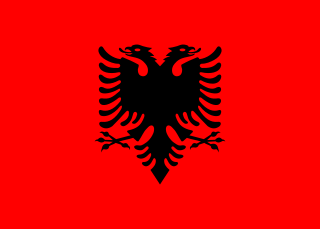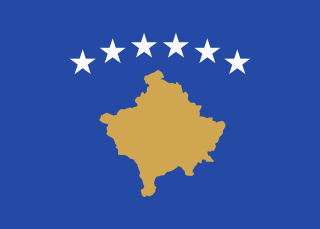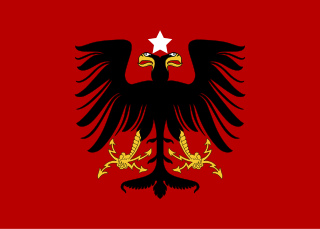
Albania, officially the Republic of Albania, is a country in Southeast Europe on the Adriatic and Ionian Sea within the Mediterranean Sea. It shares land borders with Montenegro to the northwest, Kosovo to the northeast, North Macedonia to the east, Greece to the south and a maritime border with Italy to the west.

The flag of Albania is a red flag with a silhouetted black double-headed eagle in the center. The red stands for bravery, strength and valor, while the double-headed eagle represents the sovereign state of Albania. The flag was established as the national flag of Albania when the country gained its independence from the Ottoman empire in 1912.

Prince Wilhelm of Wied, reigned briefly as sovereign of the Principality of Albania as Vidi I from 7 March to 3 September 1914, when he left for exile. His reign officially came to an end on 31 January 1925, when the country was declared an Albanian Republic.

The coat of arms of Albania is an adaptation of the flag of Albania. It is based on the flag and seal of Gjergj Kastriot Skanderbeg. The emblem above the head of the two-headed eagle is the helmet of Skanderbeg, surmounted with billy goats' horns. The eagle is considered to violate the conventional rule of tincture, which forbids placing a colour upon another colour.
The postal history of Northern Epirus, a region in the western Balkans, in southern modern Albania, comprises two periods; 1912–1916 and 1940-41. Northern Epirus was under Greek administration during the First Balkan War (1912–1913), but it was then awarded to the newly founded Albanian state by the Florence Protocol (1913). During this period, Greek stamps were used. Greece withdrew from the region in early 1914. The people of Epirus were unwilling to be part of Albania, though, and launched a revolution. Under a provisional government, the independent Northern Epirus was formed in February 1914 and it eventually managed to gain full autonomy under nominal Albanian sovereignty, according to the Protocol of Corfu. Northern Epirus operated its own postal service and issued postage stamps, both official and unofficial, during that year.

In heraldry and vexillology, the double-headed eagle is a charge associated with the concept of Empire. Most modern uses of the symbol are directly or indirectly associated with its use by the Roman/Byzantine Empire, whose use of it represented the Empire's dominion over the Near East and the West. The symbol is much older, and its original meaning is debated among scholars. The eagle has long been a symbol of power and dominion.
Black eagle is a bird of prey.

The flag of the Republic of Kosovo was adopted by the Assembly of Kosovo immediately following the unilateral declaration of independence of Kosovo from Serbia on 17 February 2008. The flag is the result of an international design competition, organised by the United Nations-backed Kosovo Unity Team, which attracted almost one thousand entries. The now-used design was proposed by Muhamer Ibrahimi. It shows six white stars in an arc above a golden map of Kosovo on a blue field. The stars symbolise Kosovo's six major ethnic groups.
In Albania, vehicle registration plates are issued by the regional directorates of transport.
The traditional clothing of Albania includes more than 200 different varieties of clothing in all Albania and the Albanian-speaking territories and communities. Albania's recorded history of clothing goes back to classical times. It is one of the factors that has differentiated this nation from other European countries, dating back to the Illyrian period.

Krahu i shqiponjës is an Albanian national magazine that first appeared in the democratic post-communist period, in Tirana (Albania), in 1995, in progress of Bilal Xhaferri's magazine, which was published in Chicago, United States. The spiritual leader was and still remains Bilal Xhaferri.

Civil awards and decorations of Albania are awards and decorations that have been bestowed in Albania since its declaration of independence in 1912.

Jani Vreto (1820–1900) was an Albanian writer, publisher and important figure of the Albanian National Awakening.

Lodewijk Willem Johan Karel Thomson was a Dutch military commander and politician. He served as a member of the Dutch parliament between 1905 and 1913. In 1914 he became the commander of a newly created International Gendarmerie force in the Principality of Albania. He was killed during fighting in the town of Durrës on 15 June 1914, becoming the first Dutch soldier to be killed during a peacekeeping mission.
Order of the Eagle may refer to:
The crossed hands gesture is a hand signal that denotes Albania in International Sign. Known as duart e kryqëzuara in Albanian, it is sometimes referred to as the "eagle gesture" and is a symbol used by ethnic Albanians in Albania, Kosovo, North Macedonia, and other regions of the world where Albanians live. It is meant to visually illustrate the double-headed eagle, the main image on the Albanian flag. The symbolism of the double-headed eagle among Albanians encapsulates their ethnicity and flag, viewing it as a symbol that represents ethnic-Albanian people across the globe.

For a small country, Albania is characterised by a wealth of terrestrial and marine ecosystems and habitats with contrasting floral and faunal species, defined in an area of 28,748 square kilometres. Most of the country is predominantly of mediterranean character, comprehending the country's center and south, while the alpine affinity is more visible in the northeast.
Part One is a compilation of laws pertaining to the Constitution of Albania, that consists of fourteen articles. This part of the Constitution is the first of eighteen parts.











